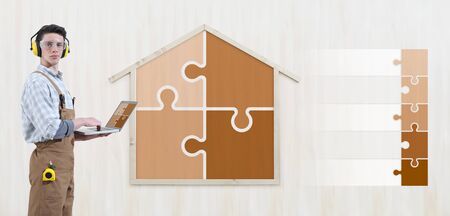Understanding Home Branding
What Does It Mean to Brand Your Home?
When you think of branding, you might picture famous logos or catchy slogans from big companies. But did you know your home can have a brand, too? In real estate, “branding your home” means creating a unique personality and story that makes your property stand out in the crowded American housing market. It’s about designing an experience, not just a space—so buyers remember your home long after their tour.
Why Home Branding Matters in the U.S. Real Estate Market
The American real estate scene is competitive. With so many homes for sale, it’s easy for yours to get lost in the shuffle. That’s where strong home branding comes in. A well-branded home:
| Benefit | Description |
|---|---|
| Creates Emotional Connections | Buyers imagine themselves living there, making them more likely to make an offer. |
| Highlights Unique Features | Your homes best qualities get noticed instead of being overlooked. |
| Boosts Perceived Value | A memorable identity can justify a higher asking price. |
| Makes Marketing Easier | Your home stands out on listings, social media, and open houses. |
How a Strong Identity Sets Your Property Apart
Think about walking into two open houses: one feels generic, while the other tells a story with every detail—from its cozy reading nook to the backyard perfect for summer BBQs. Which would you remember? That’s the power of home branding. By giving your property a distinct identity, you catch buyers’ attention and help them see why your house could be their next home.
2. Defining Your Home’s Unique Personality
Why Your Home’s Personality Matters
Just like people, every home has its own personality. When you define what makes your home special, you can create a story that connects emotionally with buyers or guests. In today’s competitive market, standing out is about more than just curb appeal—it’s about giving your home a unique identity that people remember.
Finding What Makes Your Home Special
Start by looking at your home through fresh eyes. What are the features that set it apart? Maybe it’s the charming bay window in the living room, an open-concept kitchen perfect for gatherings, or a sun-drenched backyard oasis. Walk through each room and note any architectural details, views, or upgrades that make your property unique.
Checklist: Identifying Key Features
| Feature Type | Examples |
|---|---|
| Architectural Details | Crown molding, exposed beams, vaulted ceilings |
| Functional Spaces | Home office nook, mudroom, walk-in pantry |
| Outdoor Living | Deck, landscaped garden, built-in grill area |
| Modern Upgrades | Smart thermostat, energy-efficient appliances, updated lighting |
| Special Views/Location | Pond view, city skyline, quiet cul-de-sac |
Creating a Compelling Narrative
Once you’ve identified your home’s standout features, think about how they work together to tell a story. For example:
- If your kitchen is the star, focus on how it’s perfect for family dinners and entertaining friends.
- If you have a cozy reading nook, highlight it as an inviting space to unwind after a long day.
- If your backyard is spacious and green, describe it as an oasis for weekend barbecues or kids’ playtime.
Telling Your Story: Sample Narratives
| Main Feature | Narrative Example |
|---|---|
| Open Kitchen & Living Area | “Imagine hosting holiday dinners with loved ones gathered around the oversized island and fireplace.” |
| Spa-Like Bathroom Retreat | “Start every morning refreshed in your private spa sanctuary.” |
| Lush Backyard Escape | “Step outside to your personal retreat—perfect for summer BBQs and relaxing evenings under the stars.” |
The Power of Consistency
Your homes personality should shine through in every detail—from the listing photos to how you arrange furniture for showings. Use colors, decor, and even scents that reinforce the mood you want buyers or guests to feel. A well-defined identity creates lasting impressions and helps your home become truly irresistible.

3. Aligning Design Choices with Your Brand
When it comes to branding your home, every design decision you make sends a message about your style and personality. By thoughtfully choosing colors, materials, finishes, and decor, you can create a living space that tells your unique story and feels just right for you. Let’s dive into how these elements work together, with some American favorites as inspiration.
Choosing Colors that Speak to You
Color is one of the most powerful tools in home branding. It sets the mood, brings energy, or adds calmness to your spaces. For example, if you love the coastal vibe popular in American beach towns, soft blues and sandy whites can instantly evoke ocean breezes and relaxed weekends. Prefer something modern? Neutral grays with bold black accents fit right in with urban lofts across the U.S.
Popular Color Palettes by Style
| Style | Main Colors | Vibe |
|---|---|---|
| Modern Farmhouse | Whites, Soft Grays, Matte Black | Warm, Inviting |
| Mid-Century Modern | Teal, Mustard Yellow, Walnut Brown | Retro, Energetic |
| Coastal | Light Blue, White, Sand Beige | Breezy, Relaxed |
| Industrial Loft | Charcoal Gray, Brick Red, Metal Tones | Urban, Edgy |
Selecting Materials and Finishes That Match Your Brand
The materials and finishes you pick—like wood floors versus sleek tiles—help reinforce your home’s identity. Natural woods bring warmth perfect for a farmhouse or rustic feel, while metal and glass are go-to’s for industrial or modern homes seen in many U.S. cities.
Material Examples by Home Identity:
- Farmhouse: Reclaimed wood beams and shiplap walls add authenticity.
- Contemporary: High-gloss cabinetry and stainless steel appliances create clean lines.
- Cottage: Painted cabinets and vintage hardware give a cozy touch.
- Bungalow: Hardwood floors paired with simple tile backsplashes channel classic American charm.
Tying It All Together with Decor
Your choice of decor—artwork, rugs, lighting—can make your home brand come alive. For instance, gallery walls featuring family photos or local art are a hallmark in many American homes and immediately add personality. Cozy throws and patterned pillows bring comfort to a farmhouse or cottage look; geometric lamps and abstract prints boost mid-century vibes.
Quick Tips for Bringing Your Brand to Life:
- Add plants for freshness and color.
- Mix old and new pieces for depth and character.
- Choose lighting fixtures that reflect your style—like lantern pendants for farmhouse or exposed bulbs for industrial.
- Select accessories (vases, books) that tell your story or show off your interests.
The key is consistency: let your choices in colors, materials, finishes, and decor all work together so your home feels authentically “you,” just like any great brand would!
4. Telling Your Home’s Story Through Staging and Marketing
Why Staging Matters in Branding Your Home
Staging is more than just tidying up—it’s about creating a story that buyers can imagine themselves living in. When your home is professionally staged, every piece of furniture, artwork, and decor is chosen to highlight the best features of your space and reinforce the unique brand identity you want to project. Think of it as setting the scene for a movie, where your home is the star.
Key Elements of Effective Staging
| Element | Purpose | Impact on Branding |
|---|---|---|
| Neutral Colors | Makes spaces feel open and welcoming | Appeals to a wider audience, supports a “move-in ready” brand |
| Strategic Furniture Placement | Maximizes flow and showcases room size | Highlights functionality, supports a “spacious” or “family-friendly” brand |
| Personal Touches (but not clutter) | Adds warmth and personality without overwhelming buyers | Helps buyers connect emotionally with the space, enhances brand story |
| Updated Lighting & Accessories | Cleans up outdated looks and brightens rooms | Presents a fresh, modern brand image |
The Power of Professional Photography
Your home’s first impression is often made online. High-quality photos are essential for capturing the attention of potential buyers scrolling through listings. Professional photographers know how to use lighting, angles, and editing to make your home look its absolute best—making sure the unique brand identity shines through in every shot.
What Great Real Estate Photos Achieve:
- Highlight Key Features: Emphasize details that match your home’s branding—like open layouts or luxury finishes.
- Create Emotional Appeal: Help buyers picture their own lives in your space.
- Boost Online Engagement: Stand out in crowded digital marketplaces.
Crafting Listings That Tell Your Home’s Story
A well-written listing description does more than list facts—it weaves together the features and lifestyle benefits that define your home’s brand. Instead of simply stating “three bedrooms and two baths,” describe how the open kitchen is perfect for Sunday brunches or how the backyard is made for summer barbecues. Use language that speaks directly to your target buyer’s dreams and aspirations.
Example: Listing Description Comparison
| Boring Listing Text | Brand-Focused Listing Text |
|---|---|
| Three-bedroom, two-bath home with large yard. | Welcome to your family oasis! This three-bedroom, two-bath retreat features an expansive backyard perfect for playdates, gardening, or relaxing evenings under the stars. |
| Updated kitchen included. | The heart of this home is its chef-inspired kitchen—ideal for hosting friends or whipping up weeknight dinners with loved ones. |
Tying It All Together: Showings & Online Marketing
Your staging, photos, and listing description should work hand-in-hand during both showings and online marketing. Whether someone steps through your front door or clicks on your virtual tour, they should instantly understand what makes your home special. Consistency across all touchpoints reinforces your home’s irresistible identity—and makes it easier for buyers to fall in love at first sight.
5. Maintaining and Evolving Your Brand Over Time
Once youve established a strong brand identity for your home, its important to keep it fresh and relevant. Just like companies update their branding, your home’s vibe should adapt to changing tastes, neighborhood trends, and the expectations of potential buyers. Here’s how you can maintain and evolve your home’s brand over time:
Stay Aware of Trends Without Losing Your Unique Identity
It’s smart to pay attention to popular design styles and features in your area—think modern farmhouse touches, open floor plans, or eco-friendly upgrades. However, always balance new ideas with what makes your home special. You don’t have to chase every trend; instead, pick updates that fit your home’s personality.
Monitor Neighborhood Changes
Your neighborhood might evolve over the years, attracting new residents or businesses. If trendy cafes or tech hubs pop up nearby, consider updating outdoor spaces or adding amenities that appeal to the new crowd. Keeping your home in tune with its surroundings helps it stand out while feeling like it belongs.
Neighborhood Changes & Home Branding: What to Watch For
| Neighborhood Change | Branding Response |
|---|---|
| New families moving in | Add child-friendly features or safety upgrades |
| Coffee shops & boutiques opening | Create inviting outdoor spaces or add stylish curb appeal |
| More remote workers in area | Highlight home office space or tech upgrades |
Adapt to Buyer Expectations
The must-haves for buyers can shift quickly—what was trendy five years ago might feel outdated now. Stay updated on what buyers want by checking local real estate listings, talking to agents, or visiting open houses. For example, energy-efficient appliances, smart thermostats, or stylish kitchens are often in demand.
Easy Ways to Keep Your Home Brand Fresh
- Refresh paint colors with modern neutrals or accent walls
- Update lighting fixtures for a contemporary feel
- Add low-maintenance landscaping that looks great year-round
- Replace worn hardware (door handles, faucets) for instant polish
- Declutter regularly so spaces stay inviting and functional
Review and Revise Regularly
Set a reminder once or twice a year to walk through your home with fresh eyes. Ask friends for honest feedback or snap photos to spot areas needing updates. Small tweaks can make a big difference in keeping your homes brand attractive and memorable.


